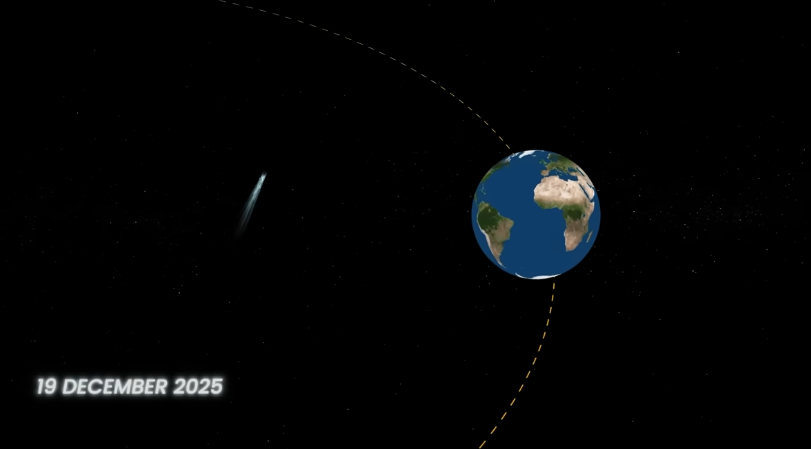New Interstellar Object Racing Towards Solar System
According to scientists there is a mysterious object coming straight towards the Earth from many star systems away and the biggest thing is that it could be the first spaceship in human history. PETER VERES, who works at the Minor Planet Center of the International Astronomical Union, has confirmed that he has just identified an object that has been seen coming in the direction of the Earth for a long time. Initially it was ignored, but recent analysis found that this object is not from our solar system and it is coming towards the Earth from a different source. Which is extremely rare because only two interstellar objects have been spotted in our equipment before this.
Questions may arise from this context. What happened to the first two interstellar objects that came? And lastly, from which direction and which planet is it actually coming from? We are going to discuss briefly about this.
Interstellar Story
Asteroid Terrestrial-Impact Last Alert System or ATLAS whose job is to detect such objects in space which can collide with the Earth. He detected this object in his survey which was first named A11PL3Z from 25 to 29 June. But what are the chances of it colliding with the Earth? To calculate this, objects are then manually screened. If the chances of collision are high, then an alert is issued for that object.
There were no special chances of collision in the trajectory, but one thing definitely came to light that whatever this object was, it was not from our solar system. Actually what happened was that its orbit was in a hyperbolic arc with an Eccentricity of 6-11.6 as shown in picture.
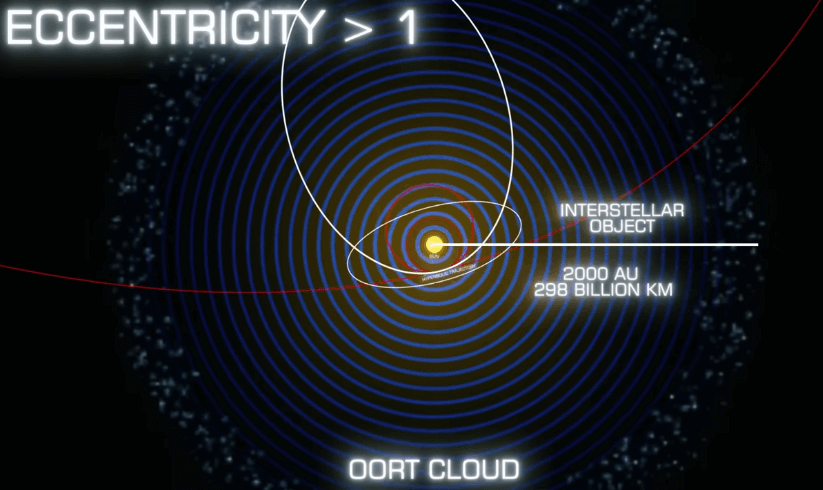
If the orbit of a cosmic body is perfectly circular, then its Eccentricity=0. But as the object goes far or near, its Eccentricity also increases. If the Eccentricity of an object is between 0 to 1, then the orbit is elliptical which is found in all the planets and major objects of the solar system. If the Eccentricity=1, it means the orbit is Parabolic, which is mostly seen in objects that are located at the very border of our solar system, near the edge of the Oort cloud.

But those whose Eccentricity>1, their orbit is hyperbolic. That is, they are even farther away from the Oort cloud. Where the gravitational influence of the Sun ends. This boundary of the Oort cloud, up to which the gravitational influence of the Sun remains, is present at a distance of about 2000 astronomical units, that is, 298 billion km from the Sun. And anything that comes into our solar system from outside this is called an interstellar object. Now since the magnitude of 6 is much greater than 1, it was declared interstellar and renamed as 3l/Atlas. But this is not the first interstellar object to enter the solar system. Before this, in the centuries-old history of space exploration, only two objects have come to the Earth from outside the solar system. And as soon as we discuss the names of both of them, we automatically understand the depth of this matter.
You can also read; Ideal Planets for life other than Earth | Super Habitable Planets
Previous Interstellars
OUMUAMUA
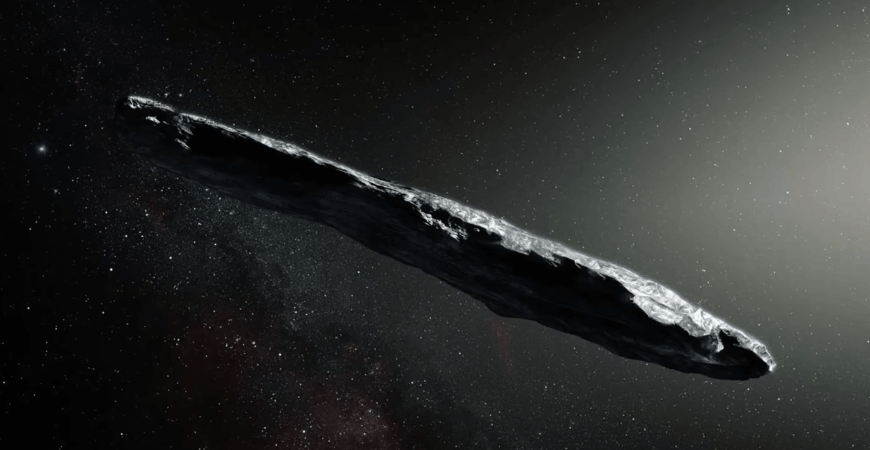
On October 19, 2017, this object was captured in the Penn STARRS1 Telescope in Hawaii. People were finding its shape strange because nothing like this had ever been seen before. But people’s interest in it increased further when they came to know that this object has come from outside our solar system. This is the picture of OUMUAMUA. No one has been able to find out till date what the first interstellar object discovered in human history was. Such objects are later declared as comets. But on 9 September 2017, when this structure was passing near the Sun, it was not emitting any kind of shining gas. Which is detected when the ice of comets starts melting due to heat while passing near the Sun. Which means that it was not a comet at all. The chances of it being an asteroid were also very low because its shape was very long and such asteroids are not found easily. But the story does not end here. Evidence suggests that OUMUAMUA was showing the characteristics of non-gravitational acceleration. In simple words, its movement was not such as if it was tied to any gravitational body. Rather, it seemed as if something was pushing it forward extremely. Just like the engine of a car gives it a push. In the same way, OUMUAMUA was also moving forward.
What was pushing that interstellar object?
2I/Borisov
An engine or some unknown concept of physics, we can never find out. Because by the year 2018, it had also gone out of the solar system. But history repeated itself again.
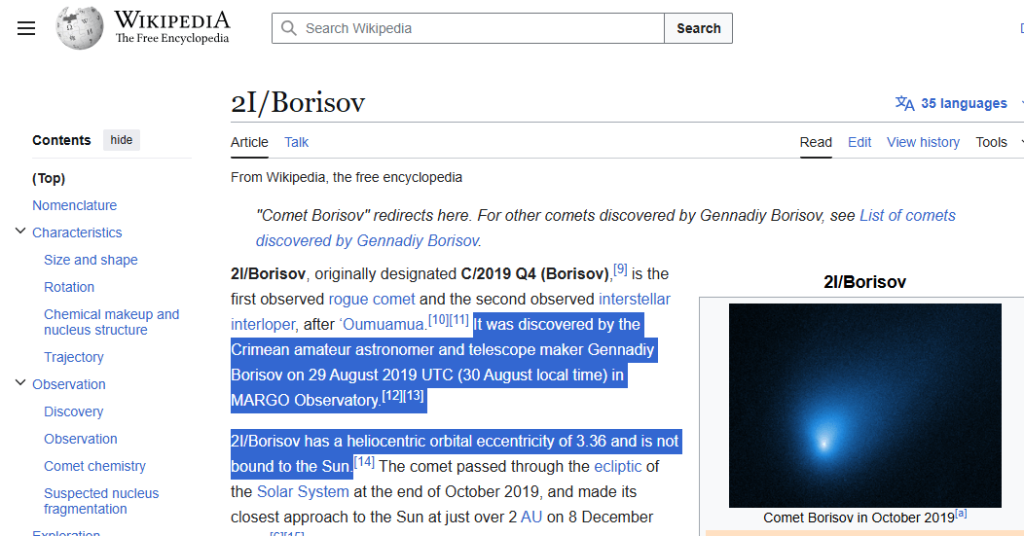
On August 30, 2019, an amateur astronomer Gennadiy Borisov spotted a comet whose orbit had an Eccentricity of about 3.36, which again indicated that it had come to us from outside the solar system. But this comet 2I/Borisov with a width of 400 to 1000 meters, looked and acted exactly like any normal comet. After entering the solar system at a speed of 32 km/s, it soon left the solar system. Due to which the time was so short that not much data could be collected. Meanwhile due to OUMUAMUA it was being speculated that all interstellar objects could be alien spaceships, Borisov refuted this misconception and presented the objects of interstellar space as normal as the solar system. The ratio was exactly 50-50. For clarity, a third object was needed and it was found in June 2025 in the form of 3I/ATLAS.
Interstellar Reality
This object coming from the direction of Sagittarius Constellation is about 10 to 20 km wide as per observation. Larger than any interstellar object found so far. It’s Eccentricity is also more than the other two interstellar objects. Meaning there are very high chances that it has come from a much farther distance than those two objects. Now currently moving at a speed of 60 km per second, this object has become the biggest hope for everyone to understand interstellar space at this time. But two questions related to this must be running into the mind. The first question is what is this object? And the second is whether it can collide with our Earth and destroy it or not? In the initial image captured by ATLAS, nothing was detected around this object. Apart from this its magnitude was also only +18.8. The magnitude could be considered as a unit that tells how bright or dim a celestial object looks from the point of observation. The lower the magnitude of an object, the brighter the object is. For example, the magnitude of our Sun is -26.832. The stars seen in the sky through small telescopes are also of magnitude around +6. But +18.8 is such a faint number in terms of brightness that it can only be observed through large telescopes. That too, when this object is kept specifically in focus. The task was difficult. But still, out of all the readings that have come so far, some telescopes have detected gases around it.
And according to the official statement, one or two telescopes have also seen tails behind it. The light that comes out from behind the comets after coming near the sun is called tail or comma in the language of cosmology. And since there are identical gases around this object, a tail like that of a comet is also visible behind it in the form of light. This makes it 90% clear that this is not an alien spaceship or an extraordinary mysterious object but a normal comet and is passing through here. Now coming to the second question that can it destroy our Earth by colliding with it? The Chicxulub asteroid that destroyed the dinosaurs had a diameter of about 30 km. 3I/Atlas was 20 km in diameter and the diameter of 3I/Atlas is twice that, i.e. up to 20 km. This means that it can definitely cause destruction. But its collision depends a lot on its trajectory. This comet was found in Jupiter’s orbit in July. And it is expected to remain there for some time. After clearing Jupiter’s orbit, it will come directly in Mars’ orbit. Where in the second or third week of October, most probably it will reach a distance of about 0.4AU from Mars and pass closest to Mars. And then looking at the turn of its trajectory, according to the predictions coming out right now.
On 19 October 2025, it will reach Perihelion and pass closest to the Sun. When the distance between it and the sun will be a little <2AU, then at that very point, due to the gravity of the Sun, the trajectory of its orbit will bend a little, due to which its direction will change and after a few years it will exit our solar system from the same direction. After October, on 19 December 2025, it will pass 1.78±0.07AU from the Earth. This distance is so much that there can be no chances of collision. And it will not come towards the Earth at all and then from this closest approach, while traveling back towards Jupiter, it will go out of the solar system and go into space. Although we may be safe, but this is a golden opportunity for us to study interstellar objects closely. Because after this, no one can predict when the next interstellar object will come.
We Have Two Plans To Observe This Interstellar Object
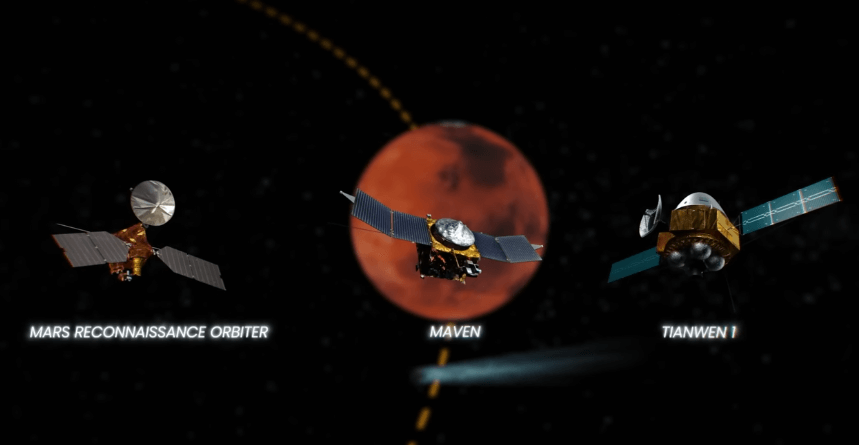
As per the current plan, we have two observation windows. The first is when it passes near Mars. At that time, all the operational orbiters such as present on Mars Reconnaissance Orbiters, Maven and Tianwen1 will try to capture as much data as possible. The second window will be available in the closest approach in December. Where it will be captured by the optical telescope of the newly operational Observatory. And only then will we get its clearest imagery.
